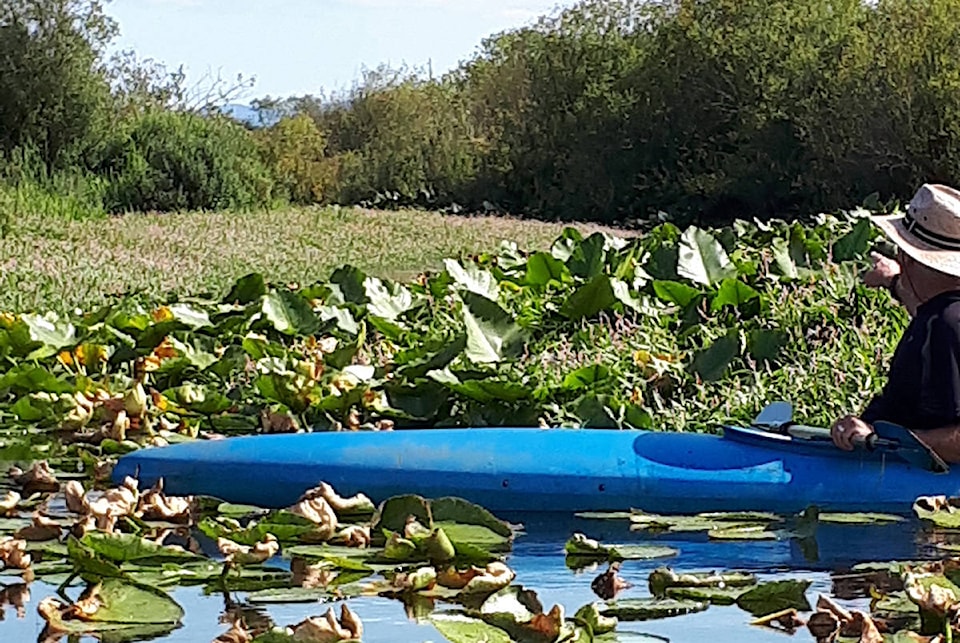Work is ongoing to improve conditions in the Somenos watershed for salmon.
Paul Fletcher, president of the Somenos Marsh Wildlife Society, recently told North Cowichan’s council that parrot’s feather, an invasive aquatic plant, now covers more than 80 per cent of the three-kilometre length of Somenos Creek.
Parrot’s feather is a popular aquatic garden species and intentional planting has spread it into natural water bodies.
The species is known to out-compete and replace native aquatic vegetation with its dense stands, and has impacted a number of freshwater bodies in B.C.
Once established, parrot’s feather is a difficult invasive plant to manage.
RELATED STORY: SOLVING PARROT’S FEATHER INFESTATION IN NORTH COWICHAN WILL BE DIFFICULT, COSTLY
Fletcher said parrot’s feather is contributing to poor water quality in the Somenos watershed and is delaying the migration of salmon in Somenos Creek, and the society is actively pursuing several management options, in collaboration with North Cowichan and Cowichan Tribes, in an effort to deal with it.
“The primary parrot’s feather management strategy has been to shade, smother and study,” Fletcher said.
“About 230 native wetland trees were planted in 2020 on the south bank of Somenos Creek to help shade the areas where parrot’s feather grows, and a 1,000 sq. ft. pond liner was installed in 2020 to smother the parrot’s feather infestation in one test section. As well, staff recently completed the 2021 parrot’s feather survey on Cowichan Tribes’ portion of Somenos Creek, and are developing a riparian-planning strategy for one of the most needed sections of the creek, between Tzouhalem Road and the Beverly Street roundabout.”
The SMWS declared a salmon emergency in the Somenos watershed last year, and said that if actions were not taken immediately to improve conditions for salmon in the watershed, they would no longer be found in the water system within a few years.
RELATED STORY: SOMENOS MARSH WILDLIFE SOCIETY DECLARES SALMON EMERGENCY IN SOMENOS WATERSHED
At the time, the society said some of the significant impacts on salmon habitat in the Somenos watershed are in-stream invasive aquatic plants, the ongoing loss and shrinkage of stream-side habitat bordering salmon-bearing creeks, and water quality issues in Somenos Lake and its tributaries.
In response to the challenges facing the watershed, the Green Streams Community Stewardship was formed, which is coordinated by the SMWS in partnership with Cowichan Tribes, North Cowichan and other local governments, adjacent landowners and conservation groups.
RELATED STORY: NORTH COWICHAN TAKING ON SOMENOS CREEK INVADER
The primary purpose of the stewardship is to monitor the Somenos watershed and to improve its water quality to help increase the number of spawning and rearing salmon.
Fletcher said the SMWS has also been researching other methods to eradicate parrot’s feather used in other areas of the world to see of those methods could be effectively used here.
He said one method is using a floating harvester to remove parrot’s feather from a body of water by either mowing or pulling it up by the roots.
“Similar vessels are being used to remove milfoil (another invasive aquatic plant) from lakes on Vancouver Island and the B.C. mainland,” Fletcher said.
“But we have some concerns about pieces breaking off and re-inhabiting downstream. At some point, we’d like to take some kind of measurement to determine if we can we control the pieces that break off and remove some of the parrot’s feather to clear the water for salmon, or if it’s not going to work for us. It’s one of the issues we hope to look at in more detail next year.”
Fletcher said a five-year Somenos watershed restoration plan is being prepared so the SMWS can start approaching funding agencies for multi-year funding to try to improve and rehabilitate the watershed’s streams so the society and its partners can get more salmon into them and start releasing larger numbers of salmon in the Cowichan River.
robert.barron@cowichanvalleycitizen.com
Like us on Facebook and follow us on Twitter
